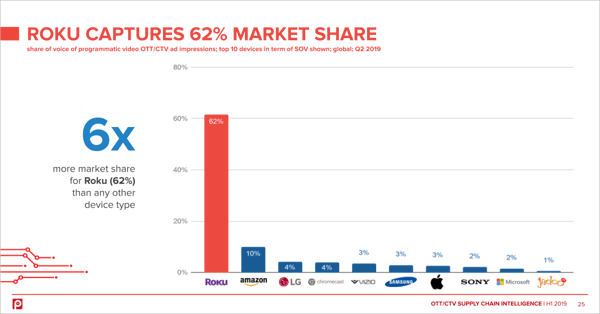
This week's review of ad fraud and quality in the digital advertising space.
Pixalate sat down with Brian Bravo, Senior Strategic Partner Development Manager at MoPub — Twitter's mobile in-app ad exchange — to discuss mobile in-app ad quality and tips for maintaining a clean supply chain.
Read our blog for more info, or watch the video here.

Programmatic OTT/CTV advertising is on the rise, but which devices are capturing the most market share of video ads? In this blog, we reveal the share of voice of programmatic video OTT/CTV advertising based on device type.
More data can be found on our H1 2019 OTT/CTV Supply Chain Intelligence report.
"Nearly half (46%) of U.S. broadband households now subscribe to two or more over-the-top services, according to a video services trend report from Parks Associates," reported MediaPost. "That’s up 130% from the 33% that subscribed to multiple services in 2014, says the research firm."

"[R]esearchers uncovered a total of 172 infected apps on the Play Store ... [with] over 335 million installs by the time they were detected by security experts," reported TheNextWeb. "Adware accounted for a staggering 300,600,000 installs ... [and] other types of malware found on Play included subscription spam, hidden ads, and SMS premium subscription software," wrote TheNextWeb, citing data from ESET malware researcher Lukas Stefanko.

AdExchanger examines how consumers will react to the upcoming California Consumer Protection Act (CCPA). "[P]ublishers and advertisers will have to show the opt-out button to California residents who haven’t yet opted out every time they visit a site and on nearly every page," wrote AdExchanger.
"Even if someone doesn’t opt out the first time, eventually they’ll probably click that button, said Bob Perkins, COO of BritePool," per AdExchanger.
*By entering your email address and clicking Subscribe, you are agreeing to our Terms of Use and Privacy Policy.
These Stories on Weekly Recaps
*By entering your email address and clicking Subscribe, you are agreeing to our Terms of Use and Privacy Policy.

Disclaimer: The content of this page reflects Pixalate’s opinions with respect to the factors that Pixalate believes can be useful to the digital media industry. Any proprietary data shared is grounded in Pixalate’s proprietary technology and analytics, which Pixalate is continuously evaluating and updating. Any references to outside sources should not be construed as endorsements. Pixalate’s opinions are just that - opinion, not facts or guarantees.
Per the MRC, “'Fraud' is not intended to represent fraud as defined in various laws, statutes and ordinances or as conventionally used in U.S. Court or other legal proceedings, but rather a custom definition strictly for advertising measurement purposes. Also per the MRC, “‘Invalid Traffic’ is defined generally as traffic that does not meet certain ad serving quality or completeness criteria, or otherwise does not represent legitimate ad traffic that should be included in measurement counts. Among the reasons why ad traffic may be deemed invalid is it is a result of non-human traffic (spiders, bots, etc.), or activity designed to produce fraudulent traffic.”

